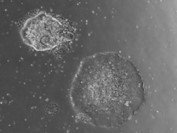Provision of a New iPS Cell Line for Clinical Use
RESEARCHES

SeV-based iPS cell colonies established by the CiRA Foundation
1. Abstract
- The CiRA Foundation is beginning today (April 5) the provision of a new clinical grade iPS cell line made using Sendai Virus (SeV-iPS cells).
- The reprogrammed cells came from the peripheral blood of an American donor, transfected using the Sendai virus (SeV) vectors1 and expanded in the GMP facility.
- SeV-iPS cells are conformable to the donor eligibility regulations of Japan, the U.S., and Europe.
- SeV-iPS cells expand the options of iPS cell lines for clinical use.
- The donor for this SeV-iPS cells is not homozygous in HLA2-A, HLA-B, and HLA-DR.
2. What are SeV-iPS cells?
The CiRA Foundation has established iPS cells using Sendai virus (SeV) vectors instead of episomal vectors3 for clinical use. The SeV-iPS cells were generated from the peripheral blood of an American donor. The blood was collected and tested in authorized medical and research institutions in the U.S.
3. Background
CiRA_F has provided their iPS cells to research institutions and medical-related companies in Japan and overseas. Some of these partners have asked for iPS cells satisfying European and North American regulations for clinical use and some of them say SeV-iPS cells are attractive because of their high differentiation efficiency depending on the type of application. These requests are the reason CiRA_F decided to manufacture new iPS cell line.
4. Provision of SeV-iPS cells
Please take a look at「SeV-iPS cells」5. Future plans
CiRA_F plans to manufacture and provide SeV-iPS cells in which HLA are knocked out by gene editing and therefore expected to reduce the risk of immune rejection in more patients.
6. Glossary
1) Sendai virus (SeV) vector
A "vector" in genetics is a biomaterial, usually virus or plasmid (circular DNA), that transduces genes into cells. Some vectors, however, integrate into the cell's genome, risking cytotoxicity and genetic disorders. SeV vectors do not have this concern.2) HLA
HLA, or human leukocyte antigens, describe cell-surface proteins that allow the body to distinguish self-cells from non self-cells in immunity. HLA are found on most cell types, and there are tens of thousands of HLA combinations. There are three major classes of HLA, but HLA-A, HLA-B, and HLA-C, which are all class 1, have the biggest impact on immune rejection following a cell transplantation.3) Episomal vector
An episomal vector is a plasmid vector used to introduce genetic material into a cell. As a non-viral vector, it does not integrate into the cell's genome.Contact
Public Relations Group
CiRA Foundation
TEL: +81-75-312-3378
Email: contact*cira-foundation.or.jp(Change * to @.)
